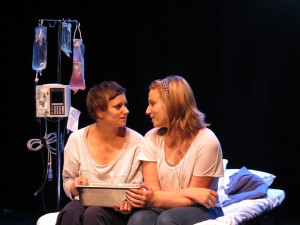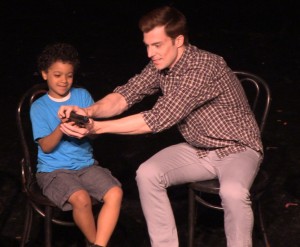Closing out Theater for the New City (TNC)’s imaginative Dream Up Festival is an unusual offering from Hungarian-American troupe Pilvax Players, titled Liselotte in May. If you’re the type who has ever wondered what it was really like as Miss Lonelyhearts in Hitchcock’s Rear Window, then look no further. The play, written by Zsolt Pozsgai, centers around the eponymous character as she becomes desperate in her search for a soulmate. Just as she turns 30, Liselotte realizes, living all alone in her New York City apartment, that she has no one to share her life with. In a pathetic attempt to find her special someone, she posts a personal ad for a husband.
Sounds like the makings of your average romantic comedy — until you take into account the fact that each one of Liselotte’s suitors end up dead on the first date! In this vein, the play is more like a romantic comedy gone haywire, with the comedy part definitely amped up in the first half. Much of the funny bits are due to Chris Kardos’ scene-stealing performances as each of the lonely heart’s various suitors.
Kardos is the ultimate character actor, effortlessly shape-shifting from one persona to the next. In one scene, he is an awkward and very nervous German butcher named Ludwig; in another, he’s a butt-crack-baring plumber with a New York accent. Each character has their own set of idiosyncrasies, and with this comes a whole lot of physical quirks, which Kardos takes on with much gusto as he falls over chairs and even gamely walks around with his coveralls dragging precariously to his knees, inciting much laughter from the audience. It is this sharp knowledge of physicality — coupled with his impeccable timing — that makes Kardos one talent to watch.
As the play’s Liselotte herself, Kata Ruzsik is a vibrant actress and quite believable as a young woman frantic in her pursuit of happiness. Despite a few rushed line readings at the beginning, Ruzsik starts to hit her stride by the second scene. She takes in just as much as Kardos gives in terms of performance, playing against his suitors well and creating an energetic exchange between them that keeps us all enthralled.
While the two actors’ comedic banter is certainly entertaining, it’s not all fun and games for Liselotte — after all, there is still the consequences of all those dead suitors to contend with. As each male character dies with each scene, the play’s tone takes a serious turn in its latter half. Maddened by the trauma of watching all of her paramours die so suddenly and tragically, the play culminates in the last of the deaths, as she meets Roland, an escaped psych ward patient whose poems Liselotte somehow seems to have memorized. It is here where her character takes a turn for the worse,
Presented by TNC artistic director Crystal Field, the whole premise behind the Dream Up Festival is for new works to push the boundaries of the form so that the play is presented in an untraditional way, and Liselotte definitely pulls this off. Much of the play — due to its inventive storytelling — felt very much like an independent film, both tonally and visually. Edina Tokodi’s set design reflects the femininity we see in Liselotte at the beginning of the play, with a simple set built around hanging canvases as the backdrop of her Bleecker Street-based apartment. As the play slowly takes its dark turn, Roland Udvari’s lighting design becomes noticeable in the form of second-long blackouts, with the actors sometimes repeating their lines — much like quick cuts in suspense films.
This particular technique was intriguing; while at first confusing, it gradually became effective as the play went on, especially by the time Liselotte met troubled Roland. It called to mind the film Swimfan, which utilizes the same method, and in the end, it created the desired effect. In fact, a lot of these moments happened throughout the latter half, sometimes repeating certain scenes after another scene had passed, giving the impression that perhaps it was all a part of Liselotte’s imagination.
Agota Hodi’s costumes are also worth mentioning, as they also echo the transition the title character goes through. At the beginning of the play, we find the still hopeful Liselotte in sophisticated heels and a demure but colorful sundress, cinched at the waist with a wide belt. She is like any other young, fashion-conscious city girl about to go on a date. As the scene-after-scene passes and bodies of her potential husbands drop like flies, Liselotte’s wardrobe is pared down to more organic, natural silhouettes and materials. For example, when we meet British radicalist Henrik, Liselotte’s costumes take on an artsy flair, as she is dressed in a white jersey dress. Then, by the time Roland comes around, she is in a loose shirt and black leggings, her hair up in a tousled bun and mascara running down her face. It is as if she morphs into the person she thinks each man wants her to be instead of them conforming to her needs.
Liselotte in May is certainly a play that explores the boundaries of imaginative storytelling and takes it to new heights. While it hit some snags rhythmically at the start, it eventually gains momentum and dares to challenge the way a play is performed. Supported by an outstanding cast and creative team, every element of the play — from the set to the lighting to the costumes — helped to achieve their vision cohesively and to great effect. Liselotte in May teases, delights and shocks to the core and makes for a memorable visit to the theater.










